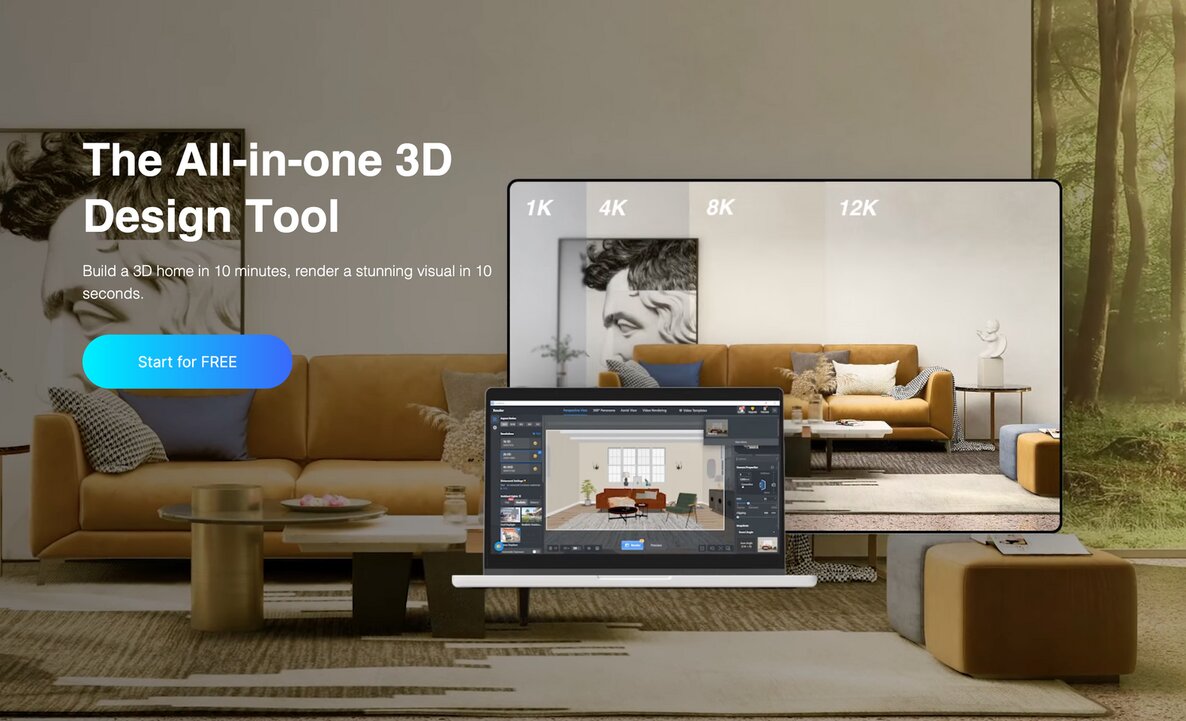The rise of 3D visualization in eCommerce has been a significant trend in recent years. Traditional eCommerce platforms typically relied on 2D product images and descriptions to showcase products to customers.
However, with technological advancements and the availability of powerful devices, 3D visualization has become a game-changer for the industry. 3D visualization allows customers to interact with products more immersive and realistically, giving them a better understanding of the product’s features, design, and functionality.
In this blog post, we will discuss the benefits of 3D visualization for online stores and give tips on how to harness 3D Virtualization in the eCommerce business.
Importance of incorporating 3D visualization in online stores
Incorporating 3D visualization in online stores offers several significant benefits for both businesses. Here are some key reasons why eCommerce stores should embrace 3D visualization in online stores:
✓ Enhanced product understanding
3D visualization provides customers with a more accurate and realistic representation of products compared to traditional 2D images. It allows customers to examine products from different angles, zoom in on details, and even see how they function. This enhanced understanding leads to more informed purchase decisions and reduces customer dissatisfaction.
✓ Increased customer engagement and interactivity
3D visualization helps to deliver an interactive and immersive shopping experience. So customers can actively engage with products by rotating, zooming, and exploring them in a virtual environment. This interactivity enhances customer engagement and can lead to increased time spent on the website and higher conversion rates.
✓ Reduced product returns
One of the significant challenges in eCommerce is product returns due to mismatched customer expectations. 3D visualization can help address this issue by giving customers a more accurate product representation. By allowing customers to view products from different angles, 3D visualization helps manage customer expectations and reduces the likelihood of product returns.
✓ Competitive advantage
The eCommerce market is highly competitive, so online stores that want to get a competitive edge should consider incorporating 3D visualization. It sets them apart from those competitors who still rely on traditional 2D images. So, by offering a more immersive and engaging shopping experience, businesses can attract and retain customers who want to interact with products before making a purchase.
Moreover, by incorporating 3D visualization in eCommerce, you can create immersive product experiences that customers are more likely to share, amplifying word-of-mouth marketing and driving increased brand exposure.
✓ Brand differentiation and trust-building
By embracing 3D visualization, online stores can showcase their commitment to innovation, customer experience, and product transparency. This can build customer trust and differentiate the brand in a crowded marketplace.
✓ Cost-effective marketing and product development
ECommerce stores can utilize 3D models for marketing materials, including advertisements, social media posts, and product catalogs. Thus, 3D visualization can be extremely helpful in product development. In addition, partnering with a digital marketing agency experienced in 3D visualization can further enhance the utilization of 3D models for marketing materials, enabling eCommerce stores to create compelling visuals that engage customers across various digital platforms.
All these factors prove that incorporating 3D visualization is essential for eCommerce stores to meet customers’ evolving expectations, enhance their shopping experience, and ultimately improve their bottom line.
How to effectively use 3D visualization in eCommerce
3D visualization in eCommerce offers numerous opportunities to enhance product presentation and create a more engaging and immersive shopping experience for customers. Here are some ways in which 3D visualization can be used to enhance product presentation:
Enhancing Product Display and Detailing
3D visualization in eCommerce can significantly enhance product display and detailing, providing customers with a more immersive and realistic shopping experience. Here are several ways in which it’s possible to utilize 3D visualization to improve product presentation:
✓ Interactive product views
Instead of relying on static images, 3D visualization allows customers to view products from multiple angles and zoom in on specific details. This interactivity provides a better understanding of the product’s features and quality, reducing uncertainties and increasing confidence in purchasing decisions.
✓ Virtual try-on
3D visualization can enable virtual try-on experiences, so customers can see how a piece of clothing fits on an avatar that matches their body type or virtually applies makeup to see how it looks on their own face. This technology helps overcome the limitations of traditional online shopping and reduces returns due to sizing or color mismatches.
✓ Customization and personalization
With 3D visualization, customers can personalize products according to their preferences. They can choose different colors, materials, or configurations in real-time and see an accurate representation of the customized product. This feature enhances customer engagement and fosters a sense of ownership and satisfaction.
✓ Improved product detailing
3D visualization enables the display of intricate product details that may be challenging to capture with traditional 2D imagery. Customers can inspect the texture, material, and fine features of a product with greater clarity. This level of detail builds trust and helps customers make informed decisions, especially for high-value or complex products.
✓ Enhanced mobile shopping experience
As mobile devices become the primary online shopping means, 3D visualization can optimize the experience. By offering interactive and immersive product displays, it enables customers to explore products easily on smaller screens, reducing the need for physical interactions.
By implementing 3D visualization techniques in eCommerce, businesses reach various goals. However, it’s essential to ensure that the 3D visualizations accurately represent the actual products and provide a seamless and intuitive user experience.
Customization and personalization
Customization and personalization are essential elements in enhancing the customer experience within eCommerce. The use of 3D visualization technology plays a significant role in achieving these objectives. By employing 3D visualization, eCommerce platforms can offer customers the ability to customize various aspects of a product, such as colors, materials, sizes, and configurations. This interactive experience allows customers to visualize the final product and make more informed purchasing decisions.
Furthermore, 3D visualization enables virtual try-on experiences, allowing customers to virtually try on clothing, eyewear, or cosmetics, using augmented reality technology. By seeing how a product looks on them in real time, customers can be more confident in their choices and reduce the likelihood of returns or exchanges.
Additionally, by collecting and analyzing customer data, eCommerce platforms can utilize 3D visualization to provide personalized recommendations and offer tailored to individual preferences. This level of customization and personalization enhances the customer’s shopping experience, leading to increased satisfaction, higher conversion rates, and improved brand loyalty.
Lastly, don’t hesitate to prioritize email security and implement the DMARC policy, as it plays a crucial role in ensuring the protection and integrity of sensitive information related to 3D models, product designs, and customer data.
Augmented Reality Integration
The last step for integrating 3D Visualization is to leverage AR technology. It allows customers can visualize and interact with virtual products in the real world, enhancing their understanding and confidence in the purchase.
One application of AR integration is a virtual try-on. Customers can use their smartphones or other AR-enabled devices to superimpose virtual versions of products like clothing, accessories, or cosmetics onto themselves. They can see how the items look and fit in real-time, without physically trying them on. This technology saves time, eliminates the need for physical returns, and provides an engaging shopping experience.
AR integration also allows customers to place virtual products in their physical space. This feature helps customers make informed decisions by visualizing how the product will fit into their environment, increasing satisfaction and reducing uncertainty.
Furthermore, AR integration can enhance product education and demonstration. Through AR overlays, customers can access additional information, interactive guides, or product demonstrations. For complex products or those with intricate functionalities, AR can provide step-by-step instructions or visual cues to help customers understand how to use the product effectively.
To sum up
Businesses in the eCommerce industry should consider adopting 3D visualization to stay competitive. With the increasing demand for personalized and interactive shopping experiences, integrating this approach can differentiate businesses from their competitors.
This immersive experience enhances customer satisfaction and reduces returns or exchanges. By embracing 3D visualization, businesses can tap into the potential for increased customer engagement and sales, resulting in improved revenue and brand loyalty.
In our article, we discussed how to apply 3D Simulation for online shopping. By following these tips, you can skyrocket your eCommerce businesses.
Social Contact:
LinkedIn | Facebook | Instagram | Twitter | YouTube
Media Contact:
>>> Schedule a DEMO!

